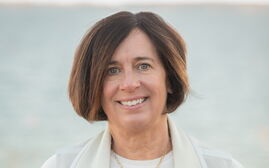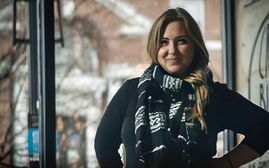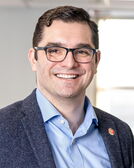Internet raises stakes for trademark practice
 PHOTo / Tim Greenway
Jim Keenan, a trademark attorney at Bernstein Shur, counts Shipyard Brewing Co. in Portland as one of his clients with increasingly complex trademark concerns.
PHOTo / Tim Greenway
Jim Keenan, a trademark attorney at Bernstein Shur, counts Shipyard Brewing Co. in Portland as one of his clients with increasingly complex trademark concerns.
What would UPS be without its brown trucks, or Fenway Park without Fenway Green walls? Colors, names, packaging and logos all form a company's identity and a consumer's impression and recognition of it. That translates into value, something companies want to protect.
Jim Keenan, shareholder at Portland law firm Bernstein Shur, early in his career realized that protecting those company assets could turn into a big business, and he became a trademark specialist. Over the past decade, the firm went from filing 10 to 15 new trademark applications annually to several hundred today. The trademark practice now contributes about 10% to the law firm's business, and has brought Keenan acknowledgement as having the most active trademark practice in northern New England.
Unlike other local law firms tackling intellectual property protection, Bernstein Shur doesn't file or prosecute patents. But with its specialty, and notably its location in Maine, it is able to offer lower rates on trademark applications than law firms in Boston, making it a better value for mid-market companies, according to Keenan.
Mainebiz talked to him recently about the growing importance of trademarks and the protections they afford. The following is an edited transcript.
Mainebiz: Have trademarks become increasingly important?
Jim Keenan: The notion of the importance of clearing and protecting a company's trademark has become more common. When I started practicing in 1998, which was pre-dot.com and pre-Internet, a lot of small- to mid-sized businesses were local or regional, so this notion of other people out there having similar names was not as great a concern, so long as they're not in my neighborhood or my state or my region. With the Internet, companies began to compete at first nationally, and then globally, and all of a sudden similar small businesses in California and Maine may have lived their entire business lives without a concern about their brand, but now they're online and they're having domain name issues and eventually they could be competing for customers.
MB: So that was the first real spark for trademarks?
JK: I think it brought an awareness of the importance of brand and being proactive in protecting it came down-market to more mid-sized and small companies. It's an old form of intellectual property. I like to say whenever you think of trademarks think of cows. You've heard the word 'brand' associated with trademarks. Well, it literally came from the branding of cows. The purpose of a trademark is to allow consumers to understand where a product or service comes from, so that every time you see a can of Coca-Cola on the shelf you don't have to go and do an independent analysis of what's in the can. Trademarks have been one of the more important pieces of intellectual property for centuries.
MB: What are the differences in protection among trademarks, copyrights, patents and trade secrets?
JK: Patents protect new, non-obvious inventions, generally something more specific than concepts. It's the new mousetrap, the way it works. A trademark protects the name, the logo, that provide consumers with an awareness [of the brand]. So it might be the name of the mousetrap. Copyright protects an original expression of a person's idea, not the idea itself. A trade secret is something that is of value, that is a secret and that is not obtainable by others through proper means. The best example is the secret formula of Coke. When you're in one of those four bins you have a body of law that protects you in certain ways. Often you fall between bins and the question is how to protect that. The answer is a contract.
MB: Are there misunderstandings about trademarks?
JK: Yes. A big part of my practice is resolving trademark-related disputes or confusion. One common issue that arises is when a business forms and the person who starts it selects a corporate name. A second decision is what is the name that everyone in the public knows you as. And when you begin to market using that name, you've now transitioned into having a trademark and owning a trademark.
MB: Is trademark synonymous with brand?
JK: A trademark could be a logo, a type of device, it can be packaging. The brand would be all of the trademarks as a family, the overall impression of the company. If you're thinking of a Starbucks you're looking at its logo, name and design, that all becomes part of its brand. Brand is used somewhat interchangeably with trademark.
MB: And all those things can be trademarked?
JK: Colors, logos, designs and sounds, anything that communicates to a consumer that a product or a service is from someone. The 'Green Giant,' the 'Green Monster' and UPS's brown for delivery trucks. No one can use that color for a competing service because that might cause confusion. So the idea behind that is every time you see a brown delivery truck you know it's UPS, which makes it seem more ubiquitous. And so it gives it value.
Next time you go into the supermarket, if you begin to think like a trademark lawyer, you'll begin to see the shelves in an entirely different way. If someone changes the name from Tide to something else, you probably wouldn't know that until you get home because you'll walk along and pick the red bottle with a certain design. There's so much that goes into the psychology of consumers and how they interact with a brand, and you protect your marks around that.
MB: How far in advance should a company start the trademark process, since product brands can change at the last minute?
JK: What we tell clients is if you're forming a new company, that's a great time to start thinking about it, because you're going to select a name for your new company that you want to broadcast to the outside world. You want to make sure that's a name that no one else already has in your space that might cause confusion, because you may need to change it. The other point is you have a new product or service you want to have a name for before you go to market. It's best to clear that, which [involves] various levels of searches to see what else is out there.
MB: Is the trademark as rigorous as a patent search to clear?
JK: There are a couple of different levels, and we offer two. One is a search of the U.S. Patent and Trademark Office database to see if there are any existing applications or registrations for same or similar names in the same or similar space. Those are generally the factors that go into a confusion analysis. If we don't see anything there we'll often recommend that clients do a full search, which goes through Thomson Reuters and looks for corporate names, it searches the Web, it does a global search. We tell clients before you do any of that, run your own Google search. And just because a name is being used doesn't mean you can't use it. For example, there's the Monster job-placement service, Monster energy drink and Monster for audiovisual cables. Three different companies are using the term “Monster,” but consumers are not likely to think they're all the same company.
MB: Is there any name that is synonymous with everything, like Disney?
JK: Trademarks originated as this consumer protection device so consumers understand what they are buying. Over the past decade or so, it's really drifted into more property rights to be owned by a company. And so what's arisen in the past decade is what's called 'famous marks' in the United States that have broader levels of protection. So even if a consumer doesn't get confused that something may be from Disney, you may be tarnishing or diluting the Disney brand. And that has become actionable.
The United States is making [fewer products] as a country. What we're good at is [being] creative and licensing that across as many platforms as we possibly can. The licensing world is a big part of what I do.
MB: So companies are getting into businesses they never thought they would be in?
JK: Yes. Capt'n Eli's is a good one. Shipyard makes a soda line Capt'n Eli's and then they actually made a comic book and have an online presence. It's a different, but related company. We've had some apparel brands that have crossed apparel lines. Eastland Shoe is a longtime manufacturing company in Maine. Ultimately the manufacturing went abroad and now they're a brand-oriented company. They brought back some manufacturing, such as the 'Made in Maine, USA' brand. People really have gravitated toward that.
MB: How much of a role does the Internet play in branding?
JK: You'll be amazed at how much domain names drive branding decisions. People try to find a domain name that's open.
MB: How about geographic terms like 'Maine lobster,' since the lobsters actually move around to other states?
JK: In other countries they have geographical indicators, like Champagne or Tequila. The United States doesn't currently have those. So there's no ability for the Maine lobster industry to really enforce Maine lobster being from Maine. We represent different people in the lobster industry and they've done work around certification marks, which certifies that a product meets a certain standard, and there's a Maine lobster certification mark to denote that it's caught in Maine and processed in a Maine facility.
MB: Do you have any tools to help you track all the details?
JK: We maintain our own database so all of our clients' marks are in it and we track all the communications we have with clients, third parties and the U.S. Patent and Trademark Office. And then we track all the various dates they need for maintenance filings or renewals.
MB: How did you get into the trademark specialty? How big a business is it?
JK: I think I might have the most active practice in terms of the number of applications I file each year and I think I'm one of the few whose practice is just trademark-specific. I file 200-300 applications a year. We've got about 1,800 under our belt in the United States in various stages, probably one-third of them still pending. When I first joined the firm, I thought this notion of brands would become a lot more important and relevant because of the Internet. I began to first work with existing firm clients who had not taken active steps to protect their brands and I started my practice.
I also realized early on in terms of filing the applications and prosecuting them through registration, it was a known set of services, so I developed a fixed-fee practice. I wanted to build a portfolio of clients. There would be issues and disputes we could help them with as they grow. That seemed to resonate with clients and I got referrals and it grew from there. A clearance search is $1,000 or less. A patent is 10 times that. A full clearance is $2,500.
In the United States, it's first to use, not first to file like patents, which makes clearance important. Trademarks last 10 years, depending on the country, and then you renew it. It's good as long as you use it.
MB: Do you have any tips for those seeking a trademark?
JK: Try to start with a name you can own. Gravitate from descriptiveness and pick something arbitrary. Try to build exclusivity.














Comments